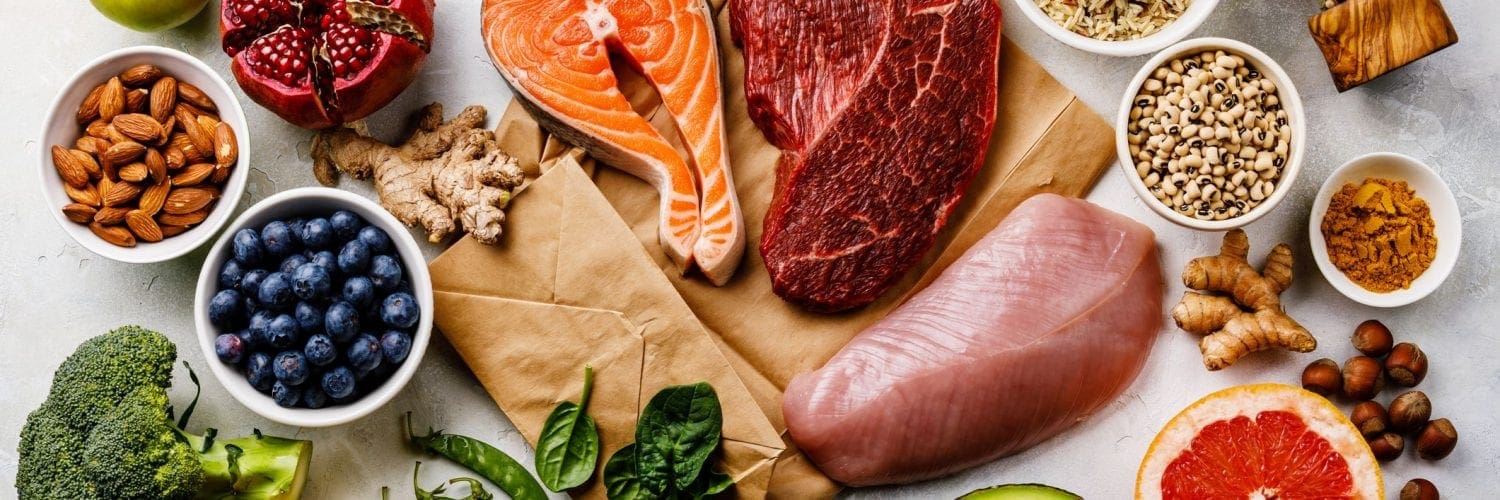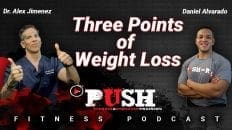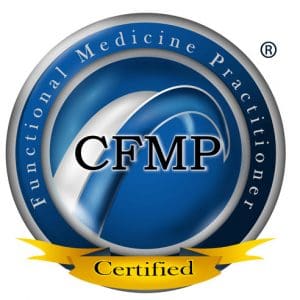PODCAST: Dr. Alex Jimenez, Kenna Vaughn, and Lizette Ortiz discuss the importance of nutrition and diet for overall health and wellness as well as how several food substitutions can ultimately help people lose weight and avoid food sensitivities. The standard American diet is made up of processed, packaged foods that have too many ingredients that can cause a variety of health issues associated with diseases like diabetes, among others. The following podcast discusses how working with a client and closely developing a good diet for them can help improve their overall health and wellness. Dr. Alex Jimenez, Kenna Vaughn, and Lizette Ortiz share various delicious and healthy recipes. – Podcast Insight
[00:01:54] Hey, guys, we’re coming to you live from the amazing Push Fitness Center. Today, we have an amazing, amazing guest that is now a regular, I do believe, Lizette Ortiz, who’s got a lot of amazing dynamic changes for diets. What we were talking about last week was how we can make diets better for us and make them fun. Today, our focus is focusing on specializations and choices and options changing our foods so that it makes it easy for us to kind of see. So substitutions is the topic today of foods specifically with the flare of Lizette Ortiz. So we’re going to kind of take a look at that. So, Lizette, tell us a little bit about what you’re going to do today. Because we’re gonna talk about a little bit about nutrition and food substitutions because I know that you’ve got a lot of knowledge and a lot of insights. So we want to be able to present that information for people to kind of get it to enjoy different options. So take it away. You got it. Tell us a little bit about substitutions. [00:02:54][59.8]
[00:02:54] Thank you. Thank you. And thank you for having me again. [00:02:56][1.8]
[00:02:56] Oh, absolutely. Super fun here. And Kenna, by the way, she’s over there on the other side. So if you want to see Kenna, where she is, there she is. [00:03:05][8.4]
[00:03:11] So basically, as we talked about last time, a lot of what I’d like to tell my clients if they want weight loss, if they just want to live a little healthier, feel better, is kind of decide what you want to include in your diet and what you don’t. When we include way too much of a lot of different things, it usually doesn’t work out very well. So it’s good to know what to cut back on and how-to, more importantly, which is what we’re talking about today is how to be able to still enjoy your favorite foods, your favorite flavors, but without those added calories from extra fat, extra grains, extra carbs, simple carbs that aren’t really needed. And especially I believe that locally here in El Paso, the Mexican diet is very, very obviously popular. And we’re just a lot of us are raised on that, you know, so to suddenly one day be like, well, no more tortillas for you, no more chilaquiles, no more tacos. [00:04:04][53.5]
[00:04:05] It’s like well that’s my identity. And it’s not easy to keep that lifestyle. It’s not sustainable when your culture is part of it. It’s like when I was living in Japan, for example, try to tell a Japanese person or a Korean person or an Asian person in general. All right. So no more rice for you, well no it’s their diet. It’s a staple of their diet. And it’s like with Mexican people is the same it’s like, oh, OK. So no more beans and no more tortillas for you. No, that doesn’t work out. So what I would like to talk about mostly today is some of my favorite substitutions that I’ve made so that I can continue to enjoy Mexican food because I do love Japanese food and Italian food. But Mexican food is my favorite. [00:04:54][49.3]
[00:04:55] But this is going to be with a healthy flair. We’re gonna make it really good for us and we’re gonna make sure that we make our families happy. [00:05:03][8.3]
[00:05:04] Our families healthy. And I’m excited about this presentation today. So we got a lot of pictures that are really cool. So let’s get it on. [00:05:11][7.7]
[00:05:12] All right. So let’s start with our prezzie, our first one. This is one of my favorite go-to’s, not only because it has a Mexican flavor to it, but because it’s a one-pan meal or a one-bowl meal, one-dish meal. Gosh, I love those. They’re the best, especially if you don’t have the time. You don’t like cooking. These are the fastest dishes you can ever make. It’s really, really easy. We have a few pictures here. In the first one, you’ll see we have basically the ingredients, which for this I used the chopped for chili like pork in chunks, which is usually what is used for chile verde. So normally this would be like the substitute of chile verde, you know, pork and chile verde, which is green chili sauce. And it’s normally what made with just pork and potatoes. [00:06:02][50.7]
[00:06:03] Where did you learn how to do this particular plate? Tell me a little bit about the history of this plate. It looks good. [00:06:07][4.1]
[00:06:08] This is my thing. Yes. [00:06:11][3.6]
[00:06:12] I came up with it. This is the artist in the kitchen. [00:06:18][6.3]
[00:06:19] Yeah, this is the Ortiz salsa verde, pork and salsa verde. [00:06:27][8.1]
[00:06:30] If you know me or you know Fonzi in El Paso, that’s probably my husband because he knows a lot of people here. And everyone knows him as Fonzie. [00:06:43][13.3]
[00:06:44] We’re gonna get some insight into what you get fed. Yes. [00:06:46][2.8]
[00:06:47] Oh, my God. Yeah. He loves it. He really likes these. Luckily. Good. He’s really easy too. He’s not like, I don’t like to eat this, I don’t like to eat that. Don’t make me this, don’t make me that. He’s not like that. He’s not picky. And he luckily… reasonable, you know, reasonable. And he goes with the flow, with everything, including my choices of my menu items. So luckily. [00:07:10][23.2]
[00:07:11] So like I said, the original salsa verde stew is usually made with just pork and potatoes and salsa verde. And that’s it. You usually accompany it with tortillas. So instead of that, I added some more nutrients and more fiber and more just vegetable portions. By just chopping up some extra things. So instead of only having the three ingredients, meats, potato, and salsa. I also added some chayote, which is that green squash looking thing that you see next to the red potato. Chayote. Yes, that is a squash. It’s a type of squash. It comes in spiny varieties. And like that one that doesn’t have the thorns. When the weather’s harsh, the skin tends to be thick. So you might want to peel it, when the weather is nice. [00:07:52][41.1]
[00:07:52] Any techniques on peeling it? Just like a carrot. Or potato. And you don’t even have to. I don’t like the extra fiber skin, so I do it sometimes, I gauge it when you cut it, you’ll know if the skin is too thick. You’ll know if you want to skin it or not. So that’s also a good substitution if you just want to skip the potatoes altogether. I would substitute with the chayote there because it has a similar texture. It’s nice. It stays firm. It stays in nice little squares. It keeps its shape. And so it gives you that feeling, both visually and in your texture. [00:08:31][38.6]
[00:08:32] … [00:09:10][5.8]
[00:09:10] And so another thing that kind of also gives you a semi-similar starchy texture is carrots. So also cut those in chunks, kind of cut everything in about the same size. And so just with your chayotes and your carrots, you’ve already added so many more vegetables than the dish originally had. Right. And then on top, those are my go-to’s usually. And then on top of that, I put whatever else I have, which this time I had kale. So I just cut all the hard parts like the stems and the thick veins. I cut those out and I only use the ruffles. I’ll leave the leaves, chop that up and then some mushrooms because mushrooms are delicious and green onions because I had a lot of those. Otherwise, I would have used regular white onions. [00:09:48][37.9]
[00:09:48] … [00:10:23][11.6]
[00:10:24] I actually have the recipe for that salsa in a video. If you go to my website. [00:10:29][5.4]
[00:10:29] What’s the website? [00:10:31][1.6]
[00:10:32] The website is a little long, but it’s easy to remember, it’s DIY. Do it yourself. DIY mind-body upgrade. One word. And then there’ll be links for recipes and video recipes and things. And I have my recipe for that salsa verde. It’s really easy. You either grill. I like grilling it so in a pan or a griddle or wherever you want, you put your green tomatoes, the tomatillos in Spanish, green tomatoes, grill those, grill some onions, garlic. I always put garlic in mine and your choice of chile. Normally people will use jalapenos for it. [00:11:05][33.9]
[00:11:06] But I don’t love jalapenos, I can have them. But they’re not my favorite. So I use chile poblano instead because they have a deeper, smokier flavor. So I roast those and then you basically just blend everything together and that’s it. And you can add water. If you want it to be lighter, you can just leave it nice and thick. It’s up to you really. It’s really easy. Kenna. [00:11:25][19.4]
[00:11:26] Do you do this kind of stuff for your husband? [00:11:27][1.2]
[00:11:27] Not this tasty. Oh, I’m picking up some tips right now. [00:11:32][4.6]
[00:11:33] What do you think he’ll say if you show up and you make a plate like that, gosh, he would probably love it because he loves, like, spicy food things that we always joke around that I was raised in a house, that used salt and pepper. [00:11:46][12.9]
[00:12:02] So this is for the salsa verde. So basically, you sautee all your harder vegetables, all your starches, or chayotes, potatoes, carrots with some onions. Saute that in no more than one teaspoon of oil. So you keep the oil low. [00:12:16][13.8]
[00:12:21] And then once your meat. No, you put the onion and the meats first. Let the meat cook a little bit and then add your thick starches which is the second picture you’ll see there where it has potatoes and carrots and the chayotes all together. [00:12:44][22.9]
[00:12:45] OK. So you want to brown first. Brown your meat. OK. [00:12:49][3.9]
[00:12:49] And then toss all the starches and the bigger chunks. [00:12:53][3.9]
[00:12:54] Does that just help them not get as soggy, like keep up with the potato texture almost or. [00:13:00][6.3]
[00:13:00] Yeah. Not putting them in all altogether. It just doesn’t cook them as long. OK. [00:13:04][3.3]
[00:13:04] It’s also at least for this dish, it’s pork. So you do want it to cook thoroughly. You know, it’s very important that it cooks thoroughly, but also because I like the browning that it gives, you know, like the texture and the flavor of the meat where you let it brown a little bit first. It kind of like sears it, I guess, you know, like mini seared chunks in a way. And then you add the other things so that they start cooking. You just cook them until they’re soft. And then I added the kale at the end because it’s leaves. So kale and mushrooms go in the end because they cook really fast. And then once it looks like the starches and potatoes and things are getting to the right texture, then you add in your salsa verde and then just cover it, simmer it for at least five, 10 minutes and you’re done. [00:13:47][42.7]
[00:13:48] Any way you prep the meat at all the night before or anything, you give it any sort of like seasoning or anything. [00:13:57][8.8]
[00:13:57] No, but if you did that, it would be even better. What do you recommend doing with it? I mean, I do season. [00:14:03][5.5]
[00:14:03] Okay. So all of this you would just throw whatever seasoning to taste. I do add a lot of things. I add garlic powder on top of the actual garlic that is in there. But I add garlic powder. Sometimes I’ll add a seasoning salt a little bit. But when I use meat, I like using the English sauce, the Worcestershire sauce, my cuisine’s flavor involves that a lot and cumin. I love using cumin, garlic powder, and Worcestershire sauce is basically my go-to. A plate like this. [00:14:34][31.1]
[00:14:34] For example. How much cumin would you use on a plate like this on this whole design, like a tablespoon or teaspoon? [00:14:43][8.4]
[00:14:43] I don’t measure things, but I have it in a shaker. [00:14:58][14.8]
[00:14:59] So that’s one. Please go ahead and try it. You can use any vegetables. Again, it doesn’t have to be these vegetables. You can use broccoli. I’ve used broccoli before because that’s what I had. I always have carrots, so there’s always carrots in it. And you can use any other vegetables. You could have used spinach instead of the kale. You can use cauliflower. You can use any like any vegetables. [00:15:21][21.4]
[00:15:21] Very lean, very lean. [00:15:22][0.7]
[00:15:22] How many portions do you usually get out of this? [00:15:32][10.1]
[00:15:33] Well maybe not so good. This is supposed to be for two people. [00:15:39][5.7]
[00:15:39] I know it looks like a lot, but we only eat like one meal and then one smaller snack meal. So we need to get most of our proteins and vegetables in one big meal. So this is pretty big if you’re accompanying this with like a soup or a salad or something like that. This could be for maybe three or four people. But if this is your only meal, because there’s enough if you see how many vegetables like a carrot per person, half a potato per person, half a chayote per person. That’s already several cups of vegetables per person. Yes. And so that’s just one meal. So this would be for two people if that’s your only thing. But you can also accompany it with other things, so. Okay. Yeah. That’s about a pound of meat. We usually eat half a pound of protein each in our meal, and that gives. [00:16:22][42.9]
[00:16:22] Let me ask you, particularly in terms of choosing how much to eat in everything. Let’s say you do leg day or versus just anaerobic day. Do you change it up in terms of, you know, hey, Alfonso, you did legs today, so you get a little extra piece of meat or something, or you did aerobics and you get no meat or something? How does that work? [00:16:40][17.6]
[00:16:53] I do take that into account, how much I exercised, how much he exercised, what we did, if we remember to take our protein after we workout. What are we gonna eat later? What snacks we have for later if it’s something that’s high in protein, or not? You know, like, I’ll take a lot of those things into account. So, yeah, sometimes it’s like if I worked out. But he slacked it and it’s like we’re gonna get like the same or I’m going to get a little more. But no he’s a guy, he’s bigger, so he needs more. So it’ll probably be more even if we both worked out than he usually gets a little more protein or more whatever carb like potato in this case or something because his body just functions better with carbs. Mine functions better with fats. So I let him have more. [00:17:35][42.5]
[00:17:35] You know, that’s so cool because I think that, you know, the family knows their spouse and it knows what does, you know, what is good. And in this situation, it’s so important to be able to pick out the amplitude of the proteins and the amplitude of the carbohydrates versus the fibers. So this is very good. Important. I mean, and in a very, I think it’s one of the basic questions that as you’re to get advanced into nutrition, you really know how to gauge. And I think the world is now saying, you know what, we don’t have to eat meat every day or high proteins, specifically on the days that we work out hard, but then not on the days we don’t. So it’s kind of cool. [00:18:11][35.8]
[00:18:13] I’m gonna ask you one question first. Everyone thinks that eating healthy is really hard and it’s really expensive. This looks very budget friendly. Is it budget-friendly when you purchase all these ingredients? [00:18:26][12.3]
[00:18:26] It’s actually very budget-friendly. We were talking about this last week. Yes. [00:18:30][3.6]
[00:18:31] And Dr. J. Proposed like to save money. If you just saved money by doing it. Right. Just like I can’t spend any more money on this. So no snacks. There’s no money for snacks. And truly, I spend so much less money when I eat clean than when I eat other crap. You know, when I fill up like rice is cheaper. But where’s my nutrition, you know? Right. And that’s bland. You’re still going to want something else. You’re going to end up eating junk anyway. And junk is actually pretty expensive. Yeah, this is really cheap. Like my husband and I. It’s just the two of us. But we eat like this or you’ll see other pictures. We do eat healthy snacks. We buy. We spend maybe one hundred and fifty dollars every two weeks, but it’s all just healthy stuff. [00:19:19][48.8]
[00:19:27] There’s another thing I noticed about this is that you cut these vegetables up and there was a lot of fiber obviously in this thing. We’re not just feeding, you know, Alfonzo in his muscles. We’re feeding his bacteria. And what I love about this thing is the, you can almost see the probiotics having a hallelujah song going on. You can hear the thumps, then they’re happy all the fiber is coming in and they’re gonna enjoy this. You mentioned a couple of things like rice, OK, and versus high fiber foods like this, rice is absorbed in the first five feet of the intestine. Once it leaves, literally, it ends up injecting into your body so quickly. Really no food for the bacteria. So this is where we kind of look at it and we kind of say this is a food that’s not only good for your body, but it’s good for your bugs and your bugs. [00:20:11][44.3]
[00:20:12] Keep your whole hormone system together. Everything working right. And you know what? You know, I hate to say, but we talk about this because we’re older. And did you poop in the morning? Did you feel good? Did you know it makes a difference? [00:20:22][10.7]
[00:20:31] OK, so another delicious, delicious dish, Mexican dish that I love, especially for breakfast. I recently went to Guanajuato with my mom and my aunt and my cousin. And I swear every morning I had chilaquiles for breakfast because every hotel had them and I love them and they’re so good. However, the bad thing about chilaquiles is that you usually fry the tortillas that are used for it. And so that already sabotages your entire plan here. [00:20:59][27.9]
[00:21:00] For the whole day. Exactly. And then the eggs are usually fried eggs too, you know. So but there’s no reason for that to be the case. You can still enjoy your chilaquiles. These are honestly very small changes that I made is instead of frying the tortillas. Cut them up and bake them. I put them in the oven at about 350 for about 15 minutes. But that’s here in El Paso with our altitude and our everything. So you check, you know, check on them till they’re crispy and golden. I wouldn’t recommend putting them at any higher temperature than 350 because that would probably just be too much. It would they would burn. And then the salsa is again my salsa that I make. [00:21:42][41.4]
[00:21:52] I make it all the time, I buy the green tomatoes every time I go to the grocery store, I buy my green tomatoes and there’s always like a batch of salsa at home. And then so what I did for this is I sauteed some onions and then no, I just baked the chips and then I threw them in the pan. And then the salsa, as I mentioned, already has garlic and it has onion and it has the chile. And so that’s already a lot of flavors. So you don’t need to add oil. You don’t need to add any garlic, any onions, anything. That’s it. And so just pour it on top of the chips and kind of move it around until they start softening a little bit. Once it starts simmering, you leave it there, cover it and make sure it’s nice and hot. And then I just crack the eggs on top of that, as you can see there, and then covered it out, spread just some salt and pepper on top, some green onions, cover it for a little bit longer till the eggs are cooked to your liking. [00:22:46][53.7]
[00:23:07] He prefers four eggs, but he must have slacked on this day because I obviously only gave us three. So we both liked it I guess. And so that’s it. And you just cover it once. The eggs are nice and cooked how you want them. I took it with a scoop. I scoop it out with either a spoon or a spatula or however you want. Normally the sauce is nice and thick. If it’s too soupy, then use a spoon. But I like it either way. And just serve it. And then you see in the final picture, of course, a side of salad. Right. And it’s kind of like a chilaquiles are a type of thing that you can have for breakfast or you can have as a breakfast for lunch, breakfast for dinner type meal. So I really like them because of that. [00:23:45][37.9]
[00:23:45] I’d like to have breakfast for dinner. That is so cool because sometimes I want to have breakfast for dinner. That is so cool. Wow, that’s amazing. [00:23:52][6.5]
[00:23:53] So that was easy. That was really easy. It’s just the salsa. I mean, if you don’t want to make the salsa, you can just buy it like they sell salsa verde at the store and salsas are amazing. Like we were talking about the last time even as dressing substitutes because they don’t have any oils in them. Salsas are made by roasting or boiling or steaming some sort of vegetable and blending them together. Say that again, they’re made by how roasting vegetables or boiling or I don’t. I sometimes steam them, but for the most part it’s boiled or grilled vegetables and just blended. That’s basically what a good real salsa should be. There shouldn’t be any oil in it. Any grease, any anything. So sauces are super safe. Just go to the store, buy yourself a big salsa over there and bake your own chips and then just do the same thing. You don’t have to make your own salsa. You can always just look for something. Look at the ingredients. It should only be vegetables, maybe some salt. A couple of not so terrible preservatives, you know, like if they need to be in there. But other than that, it’s a really simple meal that the other thing that you will notice, and I’m sure some people are like, hey, donde esta el queso, where is that? [00:25:01][68.3]
[00:25:01] Where’s the cheese?. Well, that’s another thing we’re modifying here is we’re not putting cheese, so we’re cutting back on that fat. But if you want the cheese because it’s part of it, you must have it. There’s nothing wrong with grading, you know, a little bit an ounce of cheese and spreading it all over an ounce of cheese divided by two people that be nothing, even one ounce per person. [00:25:23][22.1]
[00:25:24] … [00:27:00][12.1]
[00:27:00] I use the monk fruit sweetener, which we were also talking about. Yes. Yes. And so one thing that I’m doing this summer is I’m making my own cucumber and chili lime popsicles really easy. One cucumber. Two limes. monk fruit sweetener. Chili powder. Blend it done popsicle. Pour it into the mold. Put the stick in, done. enjoy it. And it’s really easy. They’re really easy to make and they’re really quick if you want to add more flavor to them. You could use the Tajin powder. I don’t know if you’ve seen it. You can add some Tajin powder that has real sugar in it, but it’s very, very little. So I mean, you wouldn’t add more than like a tablespoon for an entire batch of…Lizette [00:27:48][48.2]
[00:27:49] You mentioned something about the monk fruit. Right. So tell us a bit about the monk fruit and what are your experiences with the monk fruit. [00:27:54][4.6]
[00:27:55] … [00:30:20][0.8]
[00:30:21] When you when you when you work with your your your clients, how is it that you kind of in when we’re looking at these particular substitutions, how do you adapt to an individual and assist them in creating a diet? That’s right for them. Like you can say, do you look at them and say, you know, this is kind of an apple shaped body, a slender body, and how do you tailor that? [00:30:42][21.8]
[00:30:44] Yeah, that’s actually a really good question. And you do you can go by body type a lot of the times because usually that kind of lets you know what kind of. [00:30:53][9.7]
[00:30:55] So what foods work better for them? What kind of exercise, how much activity and everything but over our lives we can change our bodies. So, for example, someone who is normally like a tall, skinny type. Right. If they don’t take care of themselves, they can change their body over the years for it to become a more rounded body type. And so now they’re going to have to do things that a naturally round body type will have to do to lose weight or get back into their skinny all the time shape. However, people who usually struggle to gain weight will do better with carbs. At least that’s something that has been, you know, noticed because they burn a lot. They also have a hard time putting on muscle because they just burn through all this so fast that it’s just like they need the carbs for fuel. But someone, for example, like I’m in OK shape right now, but I tend to gain weight really easily. Like, really, really, really easily. And so if I were to eat tortillas every day, like if I were to eat everyday tortillas and rice and beans and like steak, like regular Mexican meals every day and like huevos for breakfast and then like, you know, tortillas. And guisados for lunch and then like some other thing for dinner I couldn’t like my body just does not respond well for carbs. So for example, a person, in that case, I would tell them. All right, well, for your body type we’ll have to get rid of these carbs. We’ll have to get rid of grains. We have to get rid of tortillas, reduce them. At least if we don’t get rid of them completely, at least reduce them. If you’re gonna do tacos, do just two tortillas instead of four. Eat the rest with either lettuce wraps or just by itself. You know, like I’ve eaten my fair share of open-faced burritos. You know, like, I just open it and eat the insides with a fork and you’re eating the delicious stuff inside and then the bread’s just kind of extra. So, yeah, I do base it on that. And most importantly, though, I ask them, do you tend to gain weight easily? Do you like these foods? Do you like those foods? Do you struggle with this? And so that will also help me make a side. Yeah. Right. What to suggest. [00:33:11][135.2]
[00:33:11] So let me ask you, when we look at your portfolio of diets and how do you help your clients specifically retune their diets. [00:33:23][11.2]
[00:33:23] And what I mean by that is, you know, your husband, for example, Fonzi, and you know that if he eats a certain food, he just packs it on, you know, yourself. How do you work and gauge how do you tell the person and what to look for in terms of the things that make them swollen and just get kind of chunky? And how do you help them adapt? You mentioned something about the use of a diary and you mentioned something like that. Tell me, how do you do that? [00:33:51][27.8]
[00:33:52] The first thing I like to do is start with a semi elimination diet. [00:34:00][7.6]
[00:34:00] You’re going to get rid of all of these foods. And we really go really, really, really strict. And it’s like none of these. Not even any potatoes. Not even anything that could irritate you like any nightshade family. Foods like tomatoes, eggplants, potatoes, all those things. No grains. I have them like that for like at least a week. And then slowly add one food at a time and see how they feel. And then we can really gauge what is really causing inflammation, what’s causing bloating, what’s causing headaches, even sometimes. [00:34:32][31.1]
[00:34:32] What do they report to you in terms of inflammation that things aren’t sitting right? Let’s say they eat certain food and it just keeps on whether it’s milk or certain byproducts of dairy byproducts. What is it that we can help them to zone in on if it works or not? In terms of elimination, diet. [00:34:48][15.8]
[00:34:51] … [00:36:34][54.8]
[00:36:34] Yeah. I’ve said before, a lot of people associate inflammation with, like, just joint pain or a physical thing they can see, they don’t think about their intestines and how they’re eating and what it contributes to their headaches or like you said, your nausea or your bloating. You don’t realize that even like using the restroom can be so easy and simple because the foods that you’re eating are really causing inflammation in there and just wreaking havoc on all the insides because we can’t see it. So definitely detoxing is great to do, like you said, once every six months, just to give your body that clean reset. So, you know, and also you can, the food sensitivities you have can also change, you know, doing it every six months or a year. It will really help you just get better in tune with your body, which is a great thing. You should really know your body. It will help you so much and it will help you with the food you can have and even with the substitutions, it’s just a great thing to do. [00:37:54][79.1]
[00:37:54] Not necessarily, because most of my clients that I’ve had at least maybe I’ve just gotten lucky. They’re very like they’re ready. Let’s do it. Yeah, whatever it is, let’s do it. In fact, most people are surprised, you know, now that you mention it. I’m thinking about it. And most people don’t eat enough, especially with women. Yes. We tend to think, oh, well, the less I eat, the more I’m gonna lose weight. Right. It’s like, well, no, because now you’re starving yourself. So now you’re storing everything. And so, no, when I actually tell people it’s like you’re not eating enough, you need to add this many more vegetables, this many meats. What? No. [00:38:33][39.0]
[00:40:23] So you have one cucumber, two limes. I put like one tablespoon of Tajin, which is in the back. The container with a red lid is just chili powder, just regular old Mexican chili powder. And then that Lakanto monk fruit sweetener. Golden is the one that’s supposed to be kind of like brown sugar. OK. So you like the golden one. OK. I just happened to have that. But yeah. So that’s one variety that they have. Any monk fruit sweetener will work for that. Just no sugar. And so if you can see there like that whole cucumber alone has what. Thirty-five calories. Yeah, maybe. So if you put all of that and divide it up between the 10 popsicles, that means each one of those delicious. Decadently sweet and amazing… [00:41:10][47.0]
[00:41:52] So tell us a little bit about what made you, what other types of popsicles do you do? [00:41:57][5.4]
[00:41:58] Okay, so I just made some they’re not super low sugar because I took the lazy route for several reasons that I’ll explain. But I made some pineapple popsicles and I made them with. I say that I made them the lazy way because I bought the concentrate. The pineapple concentrate. OK. And I just like added water. So it has sugar. It’s like the regular just fruit juice. But it’s pasteurized because like Kenna was saying your food sensitivities change throughout life and I have become sensitive to pineapple. Oh. I used to not be. It’s a bummer. And so but you can still eat it if it’s cooked because it destroys the enzymes, right? Causing problems. And so if it’s pasteurized, it’s basically cooked. Right. [00:42:48][49.7]
[00:42:48] So the juices, any juices or canned pineapples and things are OK. So I bought that and I just didn’t want to deal with it. And I used that for my popsicles. But if you have natural pineapple, chunks of pineapple, blend it with some water, fill up your little containers, popsicle containers. You got your paletas right there. [00:43:05][16.8]
[00:43:05] I don’t want to take over this whole thing, but I kind of bumped into your page and I found a bunch of different cool things. [00:43:10][5.0]
[00:43:45] Yes, there’s always a lot going on in my salads. [00:43:48][2.9]
[00:43:49] There are always at least seven ingredients in my salad. [00:43:53][4.0]
[00:43:54] OK. So this one has, you know, your basics. Lettuce. [00:43:57][2.7]
[00:43:58] I don’t use iceberg because it just doesn’t have a lot of nutritional value. So I usually stick to something greener, either Greenleaf or a red leaf, which is what’s on there. Also, like Dr. J. Noted, Broccoli, cruciferous vegetables. I’ve got some broccoli in there. I cut it small. Someone once told me that it was hardcore to eat broccoli raw. [00:44:16][18.8]
[00:44:17] So I guess if you don’t like it raw, steam it before you throw it in there. [00:44:22][4.9]
[00:44:23] You know what? I don’t look at it just for me. I look it for my bugs. I got to make my bugs happy. My bugs have to be fed. They don’t want meat. They want some crunchy stuff. And they want to break it down. Yeah. [00:44:34][10.5]
[00:44:34] So there are mushrooms, I think. Yes. Tomatoes. And then basically the vegetables are vegetables and I just toss them with a little bit of lime and salt and oh, they give them flavor. And then the meat is just lean. [00:44:49][14.3]
[00:44:49] I think it was like ninety ten or ninety five lean beef. You can use eighty five and then just drain the extra fat if you want. And then basically just the meat has onions, garlic, celery and then your beef, red bell peppers, celery, and red bell peppers will give you your taco salad. All the flavor in the world. [00:45:09][19.5]
[00:46:23] So variety is the spice of life. Right. Right. As we all know, and so a good diet is a very diet, although you are going to notice a lot of ingredients repeat in my diet. But at the same time, I have a lot of different ingredients all the time. That said, I like to rotate what I eat depending on what I’ve done. Like we were talking about if we didn’t work out or anything, like, oh, you know, we don’t need like a steak today. [00:46:46][23.6]
[00:46:47] Right. Or we’ve been eating a lot of fish and chicken and things. So it’s like, OK, vegan day. We always have one vegan day a week usually. Yeah. Least or at least a vegetarian day. Where we’ll eat some, maybe some products like maybe eggs like an ovo lacto vegetarian. But usually, we do meatless day at least once a week, once or twice a week. We go meatless completely just for variety and to also for our little bacteria. You know, like for our little microbes, the variety, they love the veggies, they love the fiber and stuff like that. So we do chicken, fish, pork, beef, and vegan or vegetarian and a variety. Just skip it every day. [00:47:28][41.8]
[00:47:38] … [00:51:44][4.2]
[00:51:47] The best recommendation for eating is being mindful of what you’re eating and thinking, sitting next to or in front of your, you know, your family, your person, and talking and observing your food and chewing carefully. I’m going to be completely 100 percent honest with you guys. We always watch something when we’re eating. So I’m always watching TV, not TV. I mean, it’s on the TV, but who watches TV and everything is streaming. Right? So we’re together. Yes. OK. Either anime or some TV show that we’re following or something. And so we always just sit down. We set our little spot. We play our show and we eat. And it’s just I mean, it’s a ritual. [00:52:26][38.8]
[00:52:26] It’s huge. It’s a ritual. Yeah. [00:52:28][2.0]
[00:52:28] I see another plate here that is just so amazing. I don’t even know what it is. Got a lot going on. [00:52:33][5.0]
[00:52:34] OK, so this one was my response to a breakfast dish with no bread because when you think breakfast, you think eggs and toast and bacon, eggs, and bacon, there has to be toast, eggs, and bacon. There has to be something else. So if you see here, there are eggs and well, there are eggs, there are eggs under that bacon. And then there is the bacon, which was grilled or I mean cooked and then padded to take the excess oil off, chopped up. But that is served on top of sauteed vegetables. And the vegetables are a mix of I think that was just cabbage and squash, the Mexican squash. And a little bit of celery. I always add that for flavor. Hmm. And there are I believe this one had a little bit of potatoes. Yeah, I see little bits of potato in there. You can always skip the potatoes again if you’re really limiting your starches or if you just don’t do well with potatoes, you can replace them with more veggies. I’ve also made this with broccoli instead. Or sweet potatoes. Oh, the regular potatoes, the magical stuff. Yeah. So you can make this exact dish, but instead of all the vegetables there and at the bottom, I would slice two sweet potatoes flat and put them on top of that. [00:53:45][71.0]
[00:53:46] … [00:56:05][15.5]
[00:56:07] So you can make a pizza and Kenna and I were talking about it before. And you can get your eggplant and make it into a crust and bake it. And then it’s too long. I don’t want to spend that much time. So I just cut my eggplants and slices, grill them. You know, either in a big pan or a griddle. And then while that’s happening, I make my pizza sauce, which I honestly make with canned tomato sauce. I just get something that doesn’t have a lot of additives in it. Mm-hmm. Something that is just tomato and salt. And then I make my sauce, add oregano to it, add basil. Garlic, of course. And then once the egg plants are ready, they’re grilled on both sides. I put the sauce, whatever toppings, cheese, cover them or how or maybe bake them for five minutes or whatever you need to do just to melt the cheese a little bit. Again, if you see if you look at this picture, these are Hawaiian, but I don’t do ham for Hawaiian. I do bacon for Hawaiian. So I got some nitrate-free, thick, thick-cut bacon, which is mostly meat and less fat. Right. And then some pineapples since they’re cooked. I can eat them. So I chop them up. Put that on top and then grill them. And these we were able to eat by hand because I baked them a little longer so they dried out. [00:57:22][74.8]
[00:57:22] But sometimes you might have to eat them with a fork, but it still tastes like pizza and it’s amazing. And then all you would have to do because I mean, the eggplant is a vegetable. So you already have a lot of vegetables there. But you can also just put a little solid on the side, which is always a nice addition to anything. [00:57:37][14.9]
[00:58:03] Oh, okay. So. Well, to cure. Okay. Technically, they still haven nitrates. Even when they say they’re nitrate-free, they just don’t use the same ones. Nitrates are basically added to foods to cure them. So just, you know, to keep them fresh, especially hams, cold cuts, deli meats. They usually have to add these minerals because nitrates are like the minerals that they are added in there. But it’s too much sodium. So for, especially for people with, like heart conditions, they need to stay away from nitrates. Yes. So especially for them, I like to stay away just because it’s extra stuff that you don’t need. [00:58:45][42.5]
[00:59:06] …Â [00:59:56][0.0]
[00:59:57] Yeah, I’ll tell you what. And what I loved about this particular setup was that you were very considerate in terms of our bugs. I’m a big one about the bugs I got. And the fiber and all the good. The pre and probiotics to make our bodies healthy and to work as it should. I want to thank you again, guys, and I will look forward to the next rendition. We sometimes get a little kind of crazy clinical, but today we decided to bring it home because it is the answer from the kitchen to your genes and when you have the power of cooking food that affects your family’s genetics through epigenetic changes and the changes that we get into clinical in this process, you really make a difference in your future generation. So, yeah, for it’s not so obvious, but for those that know that we influence our future generations by what we eat. So goodwill and God bless. And again, we’re coming to you from the Push Fitness Center and looking forward to the next connection. Bye guys. [01:02:27][0.0]
[3443.5]
Neurotransmitter Assessment Form (NTAF)
The Neurotransmitter Assessment Form (NTAF) shown above can be filled out and presented to Dr. Alex Jimenez. The next symptoms that are listed on this form are not intended to be utilized as a diagnosis of any type of condition, disease, or syndrome, as well as any other type of health issue and complication.
General Disclaimer
Professional Scope of Practice *
The information herein on "Podcast: Learning About Food Substitutions" is not intended to replace a one-on-one relationship with a qualified health care professional or licensed physician and is not medical advice. We encourage you to make healthcare decisions based on your research and partnership with a qualified healthcare professional.
Blog Information & Scope Discussions
Welcome to El Paso's Premier Wellness and Injury Care Clinic & Wellness Blog, where Dr. Alex Jimenez, DC, FNP-C, a Multi-State board-certified Family Practice Nurse Practitioner (FNP-BC) and Chiropractor (DC), presents insights on how our multidisciplinary team is dedicated to holistic healing and personalized care. Our practice aligns with evidence-based treatment protocols inspired by integrative medicine principles, similar to those found on this site and our family practice-based chiromed.com site, focusing on restoring health naturally for patients of all ages.
Our areas of multidisciplinary practice include Wellness & Nutrition, Chronic Pain, Personal Injury, Auto Accident Care, Work Injuries, Back Injury, Low Back Pain, Neck Pain, Migraine Headaches, Sports Injuries, Severe Sciatica, Scoliosis, Complex Herniated Discs, Fibromyalgia, Chronic Pain, Complex Injuries, Stress Management, Functional Medicine Treatments, and in-scope care protocols.
Our information scope is multidisciplinary, focusing on musculoskeletal and physical medicine, wellness, contributing etiological viscerosomatic disturbances within clinical presentations, associated somato-visceral reflex clinical dynamics, subluxation complexes, sensitive health issues, and functional medicine articles, topics, and discussions.
We provide and present clinical collaboration with specialists from various disciplines. Each specialist is governed by their professional scope of practice and their jurisdiction of licensure. We use functional health & wellness protocols to treat and support care for musculoskeletal injuries or disorders.
Our videos, posts, topics, and insights address clinical matters and issues that are directly or indirectly related to our clinical scope of practice.
Our office has made a reasonable effort to provide supportive citations and has identified relevant research studies that support our posts. We provide copies of supporting research studies upon request to regulatory boards and the public.
We understand that we cover matters that require an additional explanation of how they may assist in a particular care plan or treatment protocol; therefore, to discuss the subject matter above further, please feel free to ask Dr. Alex Jimenez, DC, APRN, FNP-BC, or contact us at 915-850-0900.
We are here to help you and your family.
Blessings
Dr. Alex Jimenez DC, MSACP, APRN, FNP-BC*, CCST, IFMCP, CFMP, ATN
email: coach@elpasofunctionalmedicine.com
Multidisciplinary Licensing & Board Certifications:
Licensed as a Doctor of Chiropractic (DC) in Texas & New Mexico*
Texas DC License #: TX5807, Verified: TX5807
New Mexico DC License #: NM-DC2182, Verified: NM-DC2182
Multi-State Advanced Practice Registered Nurse (APRN*) in Texas & Multistate
Multistate Compact RN License by Endorsement (42 States)
Texas APRN License #: 1191402, Verified: 1191402 *
Florida APRN License #: 11043890, Verified: APRN11043890 *
* Prescriptive Authority Authorized
ANCC FNP-BC: Board Certified Nurse Practitioner*
Compact Status: Multi-State License: Authorized to Practice in 40 States*
Graduate with Honors: ICHS: MSN-FNP (Family Nurse Practitioner Program)
Degree Granted. Master's in Family Practice MSN Diploma (Cum Laude)
Dr. Alex Jimenez, DC, APRN, FNP-BC*, CFMP, IFMCP, ATN, CCST
My Digital Business Card
RN: Registered Nurse
APRNP: Advanced Practice Registered Nurse
FNP: Family Practice Specialization
DC: Doctor of Chiropractic
CFMP: Certified Functional Medicine Provider
MSN-FNP: Master of Science in Family Practice Medicine
MSACP: Master of Science in Advanced Clinical Practice
IFMCP: Institute of Functional Medicine
CCST: Certified Chiropractic Spinal Trauma
ATN: Advanced Translational Neutrogenomics




















